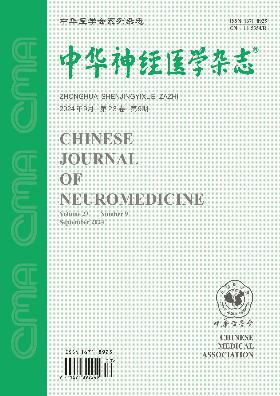Influencing factors of secondary brain injury adjacent to acute epidural hematoma after surgical evacuation
Q4 Medicine
引用次数: 0
Abstract
Objective To explore the risk factors, mechanism and treatment strategies of secondary brain injury (cerebral hemorrhage or cerebral infarction/encephaledema) adjacent to acute epidural hematoma after surgical evacuation. Methods Forty-four patients with acute epidural hematoma underwent craniotomy in our hospital from March 2013 to December 2018 were chosen in this study. According to postoperative CT or MR imaging examination results, patients were divided into group of secondary brain injury (n=11) and group of non-secondary brain injury (n=33). The clinical data of the two groups were compared, and the significance of epidural hematoma thickness in assessing secondary brain injury was analyzed by receiver operating characteristic (ROC) curve. Binary Logistic regression analysis was used to analyze the independent risk factors affecting secondary brain injury. Results After surgery, 11 showed secondary brain injury: 3 occurred cerebral hemorrhage, one of whom was diagnosed as having cerebral venous hemorrhage in the cortical vein drainage area caused by traumatic cerebral venous circulation disorder; 6 had cerebral infarction/encephaledema, and 2 occurred hemorrhagic cerebral infarction/encephaledema; two underwent secondary craniotomy and both achieved satisfactory effect. As compared with patients from the non-secondary brain injury group, patients from secondary brain injury group had significantly higher percentage of patients with epidural hematoma thickness≥33.5 mm (P<0.05). ROC curve analysis showed that the thickness of epidural hematoma had predictive value in secondary brain injury after surgery (P<0.05), and area under the curve was 0.722 and diagnostic threshold was 33.5 mm. Binary Logistic regression analysis revealed that epidural hematoma thickness≥33.5 mm was an independent risk factor for secondary brain injury adjacent to epidural hematoma after surgery (odds ratio=7.367, P=0.024, 95%CI=1.298-41.797). Conclusions Acute epidural hematoma thickness≥33.5 mm is a high-risk factor associated with secondary brain injury adjacent to epidural hematoma after surgery. Intracranial venous circulatory disorders have non-negligible effect on occurrence of secondary brain injury. Key words: Acute epidural hematoma; Cerebral venous hemorrhage; Cerebral infarction; Encephaledema; Risk factor急性硬膜外血肿术后继发性脑损伤的影响因素
目的探讨急性硬膜外血肿术后继发性脑损伤(脑出血或脑梗死/脑水肿)发生的危险因素、机制及治疗策略。方法选择2013年3月至2018年12月在我院行开颅术的急性硬膜外血肿患者44例。根据术后CT或MR影像学检查结果将患者分为继发性脑损伤组(n=11)和非继发性脑损伤组(n=33)。比较两组患者的临床资料,并采用受试者工作特征(ROC)曲线分析硬膜外血肿厚度在评估继发性脑损伤中的意义。采用二元Logistic回归分析影响继发性脑损伤的独立危险因素。结果术后11例出现继发性脑损伤:3例发生脑出血,其中1例诊断为外伤性脑静脉循环障碍所致皮质静脉引流区脑静脉出血;脑梗死/脑水肿6例,出血性脑梗死/脑水肿2例;2例行二次开颅手术,均取得满意效果。与非继发性脑损伤组相比,继发性脑损伤组患者硬膜外血肿厚度≥33.5 mm的比例显著高于非继发性脑损伤组(P<0.05)。ROC曲线分析显示,硬膜外血肿厚度对术后继发性脑损伤有预测价值(P<0.05),曲线下面积为0.722,诊断阈值为33.5 mm。二元Logistic回归分析显示,硬膜外血肿厚度≥33.5 mm是术后继发性脑损伤伴硬膜外血肿的独立危险因素(优势比=7.367,P=0.024, 95%CI=1.298 ~ 41.797)。结论急性硬膜外血肿厚度≥33.5 mm是术后继发性脑损伤伴硬膜外血肿的高危因素。颅内静脉循环障碍对继发性脑损伤的发生有着不可忽视的影响。关键词:急性硬膜外血肿;脑静脉出血;脑梗死;Encephaledema;风险因素
本文章由计算机程序翻译,如有差异,请以英文原文为准。
求助全文
约1分钟内获得全文
求助全文
来源期刊

中华神经医学杂志
Psychology-Neuropsychology and Physiological Psychology
CiteScore
0.30
自引率
0.00%
发文量
6272
期刊介绍:
 求助内容:
求助内容: 应助结果提醒方式:
应助结果提醒方式:


